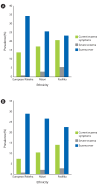Time trends, ethnicity and risk factors for eczema in New Zealand children: ISAAC Phase Three
- PMID: 23956963
- PMCID: PMC3736373
- DOI: 10.5415/apallergy.2013.3.3.161
Time trends, ethnicity and risk factors for eczema in New Zealand children: ISAAC Phase Three
Abstract
Background: Eczema is a common chronic disease which has significant morbidity and costs for children and their families. Phase One (1993) of the International Study of Asthma and Allergies in Childhood (ISAAC) found a high prevalence of symptoms of eczema in New Zealand.
Objective: In Phase Three (2001-3) we aimed to answer these three questions: Is the prevalence of eczema changing over time?; Are there ethnic differences in prevalence?; and What are the risk factors for eczema?
Methods: Five New Zealand centres participated in ISAAC Phases One and Three using the same methodology. Questionnaires about ethnicity, symptoms of eczema and environmental factors were completed by parents of 6-7 year olds (children) and self-completed by 13-14 year olds (adolescents). Prevalence and change per year were calculated by centre, ethnicity and gender. Prevalence differences between centres and associations with environmental factors were examined using logistic regression.
Results: There was little change in prevalence over time for the children, and a decrease in prevalence for the adolescents. Prevalence was higher among Māori and even higher among Pacific participants than among European children. Positive associations with current eczema symptoms were found for both age groups for truck traffic in the street of residence, and current paracetamol consumption, and for children only, antibiotics or paracetamol in the 1st year of life. Inverse associations were found with residence in New Zealand less than 5 years, consumption of milk, seafood, and eggs, and presence of a dog in the home.
Conclusion: Eczema remains a significant problem, particularly for young Māori and Pacific New Zealanders in whom less recognition of eczema and poorer access to effective, sustained eczema management may be contributing factors. Reverse causation may explain all the environmental findings apart from truck traffic which is increasing in New Zealand.
Keywords: Adolescents; Children; Eczema; Environment; Ethnicity; New Zealand.
Figures
Similar articles
-
[Prevalence of symptoms of asthma, allergic rhinitis, conjunctivitis and atopic eczema: ISAAC (International Study of Asthma and Allergies in Childhood) in a population of schoolchildren in Zagreb].Acta Med Croatica. 2003;57(4):281-5. Acta Med Croatica. 2003. PMID: 14639862 Croatian.
-
Have the prevalence of eczema symptoms increased in the Mexican pediatric population? Prevalence and associated factors according to Global Asthma Network Phase I.World Allergy Organ J. 2022 Oct 17;15(11):100710. doi: 10.1016/j.waojou.2022.100710. eCollection 2022 Nov. World Allergy Organ J. 2022. PMID: 36267354 Free PMC article.
-
Asthma prevalence in European, Maori, and Pacific children in New Zealand: ISAAC study.Pediatr Pulmonol. 2004 May;37(5):433-42. doi: 10.1002/ppul.10449. Pediatr Pulmonol. 2004. PMID: 15095327
-
Association between paracetamol use in infancy and childhood, and risk of asthma, rhinoconjunctivitis, and eczema in children aged 6-7 years: analysis from Phase Three of the ISAAC programme.Lancet. 2008 Sep 20;372(9643):1039-48. doi: 10.1016/S0140-6736(08)61445-2. Lancet. 2008. PMID: 18805332
-
Which population level environmental factors are associated with asthma, rhinoconjunctivitis and eczema? Review of the ecological analyses of ISAAC Phase One.Respir Res. 2010 Jan 21;11(1):8. doi: 10.1186/1465-9921-11-8. Respir Res. 2010. PMID: 20092649 Free PMC article. Review.
Cited by
-
Why do children under 5 years go to the GP in Lambeth: a cross-sectional study.BMJ Open. 2024 May 23;14(5):e082253. doi: 10.1136/bmjopen-2023-082253. BMJ Open. 2024. PMID: 38803264 Free PMC article.
-
The burden of atopic dermatitis and bacterial skin infections among urban-living Indigenous children and young people in high-income countries: A systematic review.Pediatr Dermatol. 2023 Jan;40(1):35-43. doi: 10.1111/pde.15153. Epub 2022 Nov 9. Pediatr Dermatol. 2023. PMID: 36349531 Free PMC article.
-
Mānuka oil based ECMT-154 versus vehicle control for the topical treatment of eczema: study protocol for a randomised controlled trial in community pharmacies in Aotearoa New Zealand.BMC Complement Med Ther. 2024 Jan 29;24(1):61. doi: 10.1186/s12906-024-04358-9. BMC Complement Med Ther. 2024. PMID: 38287323 Free PMC article.
-
The Epidemiology and Global Burden of Atopic Dermatitis: A Narrative Review.Life (Basel). 2021 Sep 9;11(9):936. doi: 10.3390/life11090936. Life (Basel). 2021. PMID: 34575085 Free PMC article. Review.
-
Efficacy of a 3% Kānuka oil cream for the treatment of moderate-to-severe eczema: A single blind randomised vehicle-controlled trial.EClinicalMedicine. 2022 Jul 15;51:101561. doi: 10.1016/j.eclinm.2022.101561. eCollection 2022 Sep. EClinicalMedicine. 2022. PMID: 35865740 Free PMC article.
References
-
- Johansson SG, Bieber T, Dahl R, Friedmann PS, Lanier BQ, Lockey RF, Motala C, Ortega Martell JA, Platts-Mills TA, Ring J, Thien F, Van Cauwenberge P, Williams HC. Revised nomenclature for allergy for global use: report of the Nomenclature Review Committee of the World Allergy Organization, October 2003. J Allergy Clin Immunol. 2004;113:832–836. - PubMed
-
- Friedmann PS, Ardern-Jones MR, Holden CA. Atopic dermatitis. In: Burns T, Breathnach S, Cox N, Griffiths C, editors. Rook's textbook of dermatology. 8th ed. Hoboken (NJ): Wiley-Blackwell; 2010. p. 24.
-
- Rycroft RJ, Robertson SJ, Wakelin SH. Colour handbook of dermatology. 2nd ed. London: Manson Publishing Ltd; 2010.
-
- Graham-Brown RA. Atopic dermatitis: predictions, expectations, and outcomes. J Am Acad Dermatol. 2001;45:S61–S63. - PubMed
-
- Williams HC, Strachan DP. The natural history of childhood eczema: observations from the British 1958 birth cohort study. Br J Dermatol. 1998;139:834–839. - PubMed
LinkOut - more resources
Full Text Sources
Other Literature Sources

